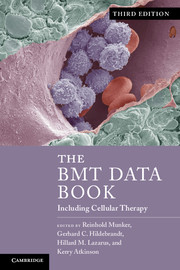Book contents
- Frontmatter
- Contents
- List of contributors
- Foreword
- Preface
- Acknowledgments
- Section 1 Basic science
- Section 2 Hematologic malignancies
- 3 Therapeutic decision making in BMT/SCT for acute myeloid leukemia
- 4 Therapeutic decision making in BMT/SCT for acute lymphoblastic leukemia
- 5 Therapeutic decision making in BMT/SCT for chronic myeloid leukemia and other myeloproliferative syndromes
- 6 Therapeutic decision making in BMT/SCT for chronic lymphatic leukemia
- 7 Therapeutic decision making in BMT/SCT for myelodysplasia
- 8 Hematopoietic cell transplantation for non-Hodgkin lymphoma
- 9 Therapeutic decision making in BMT/SCT for Hodgkin lymphoma
- 10 Therapeutic decision making in hematopoietic SCT for multiple myeloma
- 11 Therapeutic decision making in SCT for amyloidosis
- Section 3 Solid tumors
- Section 4 Nonmalignant disorders
- Section 5 Cellular therapy
- Section 6 Practical aspects and procedures
- Section 7 Complications
- Section 8 The BMT/SCT pharmacopoeia
- Section 9 HLA-testing and laboratory medicine
- Appendix Guide to the internet and literature databases relevant for BMT/SCT
- Index
- References
5 - Therapeutic decision making in BMT/SCT for chronic myeloid leukemia and other myeloproliferative syndromes
Published online by Cambridge University Press: 05 August 2013
- Frontmatter
- Contents
- List of contributors
- Foreword
- Preface
- Acknowledgments
- Section 1 Basic science
- Section 2 Hematologic malignancies
- 3 Therapeutic decision making in BMT/SCT for acute myeloid leukemia
- 4 Therapeutic decision making in BMT/SCT for acute lymphoblastic leukemia
- 5 Therapeutic decision making in BMT/SCT for chronic myeloid leukemia and other myeloproliferative syndromes
- 6 Therapeutic decision making in BMT/SCT for chronic lymphatic leukemia
- 7 Therapeutic decision making in BMT/SCT for myelodysplasia
- 8 Hematopoietic cell transplantation for non-Hodgkin lymphoma
- 9 Therapeutic decision making in BMT/SCT for Hodgkin lymphoma
- 10 Therapeutic decision making in hematopoietic SCT for multiple myeloma
- 11 Therapeutic decision making in SCT for amyloidosis
- Section 3 Solid tumors
- Section 4 Nonmalignant disorders
- Section 5 Cellular therapy
- Section 6 Practical aspects and procedures
- Section 7 Complications
- Section 8 The BMT/SCT pharmacopoeia
- Section 9 HLA-testing and laboratory medicine
- Appendix Guide to the internet and literature databases relevant for BMT/SCT
- Index
- References
Summary
Classification of chronic myeloid leukemia (CML)
Clinical variants of CML:
Typical CML (Philadelphia chromosome present, BCR/ABL-positive [94%])
Atypical CML (Philadelphia chromosome absent, BCR/ABL-positive [4%])
Atypical BCR/ABL negative CML (Philadelphia chromosome absent, BCR/ABL-negative [2%])
Staging of CML
Chronic phase:
No significant symptoms
None of the features of accelerated phase or blastic phase
Sensitive to tyrosine kinase inhibitors (TKIs) (most newly diagnosed cases, see page 64)
Resistant to TKIs
Accelerated phase (any one or more of the following criteria):
WBC count difficult to control with conventional use of TKI or busulfan/hydroxyurea in terms of doses required
Rapid doubling of WBC count (≥5 days)
≥10% blasts in blood or marrow
≥20% blasts plus promyelocytes in blood or marrow
≥20% basophils plus eosinophils in blood
Anemia or thrombocytopenia unresponsive to TKI
Persistent thrombocytosis
Additional chromosome changes (evolving new clone)
Increasing splenomegaly
Development of chloromas or myelofibrosis
Patient in a second (or subsequent) chronic phase after blast crisis
- Type
- Chapter
- Information
- The BMT Data BookIncluding Cellular Therapy, pp. 56 - 66Publisher: Cambridge University PressPrint publication year: 2013



